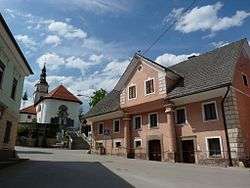Šentvid pri Stični
| Šentvid pri Stični | |
|---|---|
 | |
 Šentvid pri Stični Location in Slovenia | |
| Coordinates: 45°57′8.89″N 14°50′26.45″E / 45.9524694°N 14.8406806°ECoordinates: 45°57′8.89″N 14°50′26.45″E / 45.9524694°N 14.8406806°E | |
| Country |
|
| Traditional region | Lower Carniola |
| Statistical region | Central Slovenia |
| Municipality | Ivančna Gorica |
| Area | |
| • Total | 2.41 km2 (0.93 sq mi) |
| Elevation | 321.5 m (1,054.8 ft) |
| Population (2002) | |
| • Total | 922 |
| [1] | |
Šentvid pri Stični (pronounced [ʃɛnˈtʋit pɾi ˈstiːtʃni] or [ʃənˈtʋit-]; German: Sankt Veit[2]) is a settlement in the Municipality of Ivančna Gorica in central Slovenia. The area is part of the historical region of Lower Carniola. The municipality is now included in the Central Slovenia Statistical Region.[3] In addition to the sections of the main settlement known as Stari Trg (Slovene: Stari trg) and Zadolžna Vas (Zadolžna vas), it includes the hamlets of Travnik, Sveti Rok (German: Sankt Rochus[2]), Omotce, Postaja Šentvid, and Marof.[4]
Churches
The parish church from which the settlement gets its name is dedicated to Saint Vitus (Slovene: sveti Vid) and belongs to the Roman Catholic Archdiocese of Ljubljana. It was first mentioned in written documents dating to 1136.[5] A second church on a hill just south of the settlement is dedicated to Saint Roch and dates to the 17th century.[6]
Notable people
Notable people that were born or lived in Šentvid pri Stični include:
- Anton Črnivec (1856–1936), educator
- Marko Gerbec (1658–1718), physician
- Ivan Janežič (1855–1922), priest
- Josip Korban (1883–1966), youth writer
- Franc Ksaver Kutnar (1793–1846), prince-bishop
- Josip Mandelj (1865–1951), politician
- Ivan Markelj (1852–1903), educator
- Evstahij Ozimek (1817–1898), priest, Franciscan friar
- Janez Stritar (1818–1882), priest, religious writer
- Hugon Turk (1870–1956), veterinary physician
- Ivan Vencajz (1844–1913), lawyer, judge, politician
- Janko Vencajz (1872–1895), historian
- Stanko Vurnik (1898–1952), art historian, ethnologist, musicologist
References
- ↑ Statistical Office of the Republic of Slovenia
- 1 2 Leksikon občin kraljestev in dežel zastopanih v državnem zboru, vol. 6: Kranjsko. 1906. Vienna: C. Kr. Dvorna in Državna Tiskarna, pp. 102–103.
- ↑ Ivančna Gorica municipal site
- ↑ Savnik, Roman, ed. 1971. Krajevni leksikon Slovenije, vol. 2. Ljubljana: Državna založba Slovenije, pp. 152–153.
- ↑ "EŠD 2489". Registry of Immovable Cultural Heritage (in Slovenian). Ministry of Culture of the Republic of Slovenia. Retrieved 22 July 2011.
- ↑ "EŠD 2497". Registry of Immovable Cultural Heritage (in Slovenian). Ministry of Culture of the Republic of Slovenia. Retrieved 22 July 2011.
External links
 Media related to Šentvid pri Stični at Wikimedia Commons
Media related to Šentvid pri Stični at Wikimedia Commons- Šentvid pri Stični at Geopedia
